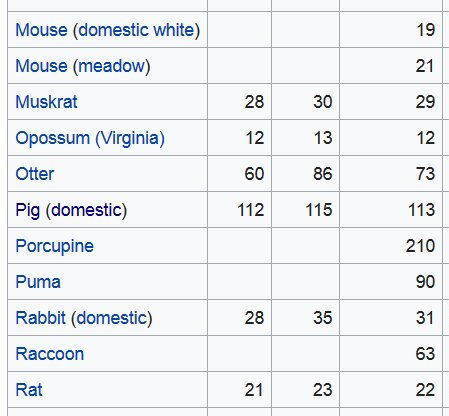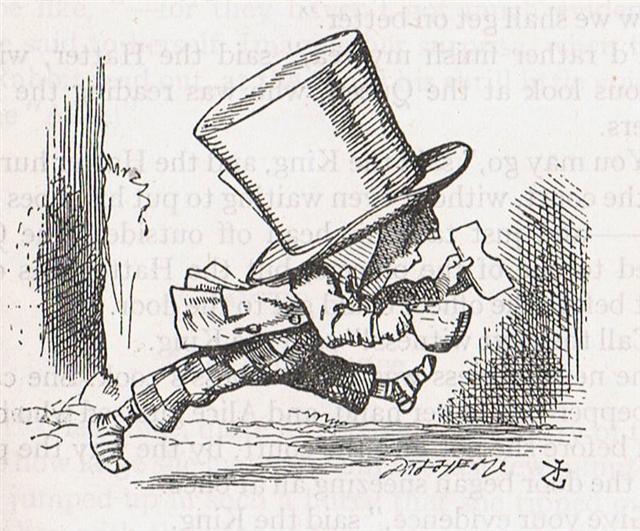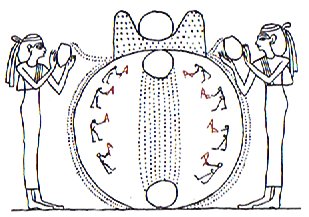We have discovered that the 'missing yam variety' glyph at Mira evidently had a connection with another glyph in the G text.
We could therefore try to search in the G text also for glyphs similar to that at the 'missing yam variety' (at Adhil / Spica). However, there is not one such but 3 (although the last one of them is somewhat weak):
Why is there not 295 but 297 days between Gb7-17 and Gb1-24? We can begin to answer this question by rearranging the order and to put Adhil / Spica at the end, viz. at day 99 (April 9):
The difference between 115 (→ the longest gestation period of the pig → Mercury → Marikuru) and number 8 (→ the dark period of Venus before her reappearance as Morning star → 236 / 29½) is 107 (→ 472 - 365).
... the Hawaiians had a sweet-potato ritual of the same general structure as the Maori cycle. It was used in the fields of Kamapua'a, name of the pig-god said by some to be a form of Lono, whose rooting in the earth is a well-known symbol of virile action ... Puaka. Animal, cattle (but not swine horu); puaka toro, steer; puaka tamaroa, bull; puaka tamaahine, heifer; tiaki puaka, neatherd. P Pau.: puaka, beast, animal. Mgv.: puaka, animal, pig. Mq.: puaka, puaá, id. Ta.: puaá, id. Churchill. Marikuru. 1. A white, clayey earth. 2. A tree (Sapindus saponaria) of which very few specimens are left. Vanaga. Ash-wood T. Churchill.
Mercury (→ quicksilver) was always close to the horizon and hard to observe, only visible at that time of the year when the Sun was moving quickly (at an equinox):
... Ganz ähnlich is der Name 'Gott von Duazag' des Gottes Nabū ... zu erklären. Er bezeichnet ihn als den Gott des Wachtstums, welches als aus dem Osten stammend betrachtet wird, weil die Sonne, die das Wachstum bringt, im Osten aufgeht. Dass aber Nabū als Ost-Gott aufgefasst wurde, hängt damit zusammen, dass sein Stern, der Mercur, nur im Osten oder Westen sichtbar ist ...
... Mercury was used in the process of curing pelts for hats, making it impossible for hatters to avoid inhaling the mercury fumes given off during the hat making process; hatters and mill workers thus often suffered mercury poisoning, causing neurological damage, including confused speech and distorted vision ...
... It happens that we know the Norse name of Gwydion's horse, if Gwydion was indeed Woden, or Odin. It was Askr Yggr-drasill, or Ygdrasill, 'the ash-tree that is the horse of Yggr', Yggr being one of Woden's titles. Ygdrasill was the enchanted ash, sacred to Woden, whose roots and branches in Scandinavian mythology extended through the Universe ...
... Number 107 plays a significant role. And like all numbers it can be explained in various ways, for instance as the difference between the total number of glyphs on the G tablet (471) and 364 (= 4 * 91). And 91 (representing the Navel of the Horse, the Topknot of Taranga, when counting from the December solstice) + 16 (as in the number of nights a star could not be observed because of its close encounter with the Sun) = 107. Therefore April 17 (107) in a certain way corresponded to April 1 (91) ...
If April 17 (107) in a way corresponded to April 1 (91 = 107 - 16), then it could be stated that April 9 (99) in a way corresponded to April 25 (115 = 99 + 16). I.e. when Adhil (the Garment's Train, ξ Andromedae) would return to visibility in April 25. ... The Explorers had left their old homeland in "April 25 (115) - implying the synodic cycle of Mercury - and they had returned half a year later, in "October 25 (298 = 115 + 183), which was 10 days after the arrival of the Royal Double Canoe ... The pig-god Tama-pua-ká Tama. 1. Shoot (of plant), tama miro, tree shoot; tama tôa, shoot of sugarcane. 2. Poles, sticks, rods of a frame. 3. Sun rays. 4. Group of people travelling in formation. 5. To listen attentively (with ear, tariga, as subject, e.g. he tama te tariga); e-tama rivariva tokorua tariga ki taaku kî, listen carefully to my words. Tamahahine, female. Tamahine (= tamahahine), female, when speaking of chickens: moa tamahine, hen. Tamâroa, male. Vanaga. 1. Child. P Pau.: tama riki, child. Mgv.: tama, son, daughter, applied at any age. Mq.: tama, son, child, young of animals. Ta.: tama, child. Tamaahine (tama 1 - ahine), daughter, female. Tamaiti, child P Mq.: temeiti, temeii, young person. Ta.: tamaiti, child. Tamaroa, boy, male. P Mgv.: tamaroa, boy, man, male. Mq.: tamaóa, boy. Ta.: tamaroa, id. 2. To align. Churchill. In the Polynesian this [tama na, father in the Efaté language] is distinguished from táma child by the accent tamā or by the addition of a final syllable which automatically secures the same incidence of the accent, tamái, tamana ... Churchill 2. Pua. 1. A zingiberacea (plant of which few specimens are left on the island). 2. Flower: pua ti, ti flower, pua taro, taro flower, pua maúku pasture flower; pua nakonako, a plant which grows on steep slopes and produce red, edible berries. 3. Pua tariga (or perhaps pu'a tariga), anciently, hoops put in earlobes. 4. The nanue fish when young and tender. Puapua, summit, top, upper part; te puapua o te maúga, the top of the mountain; te puapua kupega, the upper part of a fishing net. Vanaga. Pu'a. 1. (Modern form of pu'o), to cover up something or oneself, to put on; ka-pu'a te ha'u, put on your hat; ka-pu'a-mai te nua, cover me up with a blanket. 2. To respond to the song of the first group of singers; to sing the antistrophe; he-pu'a te tai. 3. To help; ka-pu'a toou rima ki a Timo ite aga, help Timothy with the work. 4. Pu'a-hare, to help a relative in war or in any need; ka-oho, ka-pu'a-hare korua, ko ga kope, go, give your relative a hand, lads. 5. To speak out in someone's favour; e pu'a-mai toou re'o kia au, speak in my favour, intercede for me. Pu'apu'a, to hit, to beat. Vanaga. 1. Flower, ginger, soap; pua mouku, grass. 2. To grease, to coat with tar, to pitch; pua ei meamea, to make yellow. Puapua, a piece of cloth. Mgv.: pua, a flower, turmeric, starchy matter of the turmeric and hence soap. Mq.: pua, a flower, soap. Ta.: pua, id. Ma.: puapua, cloth wrapped about the arm. Churchill. Ka. Particle of the affirmative imperative, of cardinal numerals, of independent ordinal numerals, and of emphatic exclamation, e.g. ka-maitaki! how nice! Vanaga. Ká. 1. To light a fire in order to cook in the earth oven (see umu): he-ká i te umu, he-ká i te kai. 2. Figuratively: to fire up the soul. To put oneself in a fury (with manava): ku-ká-á toona manava he has become furious. Vanaga. 1. Of T. 2. Imperative sign; ka oho, ka tere, ka ea, begone!; ka ko iha, a greeting T; ka mou, hush; ka oho, goodbye. 3. Infinitive sign; mea meitaki ka rava, a thing good to take; ka harai kia mea, to accompany. 4. A prefix which forms ordinals from cardinals. 5. The dawning of the day. 6. Different (? ke). Churchill. was said by some to be a form of Rogo, whose rooting in the earth was a well-known symbol of virile action, an idea which I guess was rooted in the equation 364.0 = π * 115.88 - which implied a close relationship between Mother Earth and Mercury (as indeed was confirmed by the observations of the astronomers).
... After that, Ira spoke these words: 'This is the diggning stick (? ko koko), Kuukuu. You shall work the land for me and plant the yam roots [te uhi]!' Makoi named the place Hanga Te Pau, 'the landing site of Ira'. So that they would remember (? he aringa, literally, 'as face'), the open side [ko mua] of Hanga Te Pau was given this name. Ira got up. They all climbed to the top of the hill. They climbed up on the tenth day of the month of June ('Maro') ... They made camp and constructed a house [te hare]. Kuukuu got up, worked the ground, and heaped up the earth for the yam roots [he puke i te uhi] ... [E:18]
|
||||||||||||||||||||||||||||||||||||||||||||||||||||||||||||||||||||||||||||||||||||||||||||||||||||||||||||||||||||||||||||||||||||||||||||||||||||||||||||||||||||||||||||||||||||||||||||||||||||||||||||||||









